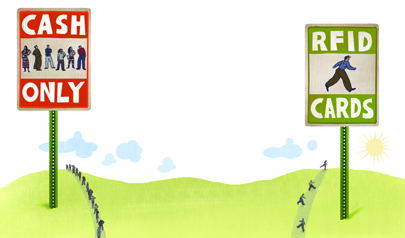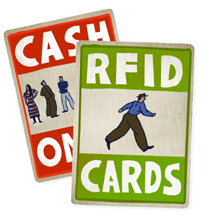Back in February 1950, a lawyer named Frank McNamara ate dinner at Major’s Cabin Grill restaurant in New York. When the bill was presented, he pulled out his wallet and handed the waiter a small, cardboard card-a Diners Club card-and signed for the purchase, ushering in the age of charge and credit cards. Ever since that meal-known in the credit card industry as the First Supper-pundits, analysts and futurists have been predicting the death of cash and the rise of the cashless society.
Fifty-five years later, some businesses and governments in the United States, Asia and Europe have introduced cashless payment systems that use radio frequency identification devices to identify purchasers. Many of these systems are being used to speed consumers through tollbooths, transit turnstiles and gas stations.
|
|
Now retailers, restaurants and other establishments have begun to recognize the benefits of RFID payment systems: Businesses can increase sales by serving more people more quickly during peak periods, and customers tend to buy more when they don’t need to worry about having cash. There are benefits for customers, too: no more waiting on long lines, fumbling with coins or worrying about having enough cash. All it takes to make a purchase is a wave of an RFID card or keychain fob by an interrogator, or reader.
There are a variety of ways that these RFID payment systems can work. Some let consumers set up prepaid accounts, which they can refill by mail, online or at select bank or merchant locations. Others charge the amount of the purchase to a credit card. But it’s the recent decision by American Express, MasterCard and Visa to issue credit cards embedded with RFID transponders that’s expected to drive adoption. Still, before RFID payment systems gain widespread acceptance, cost, privacy and technology issues will need to be resolved.
Proprietary Systems
Consumers have overwhelmingly embraced RFID payment cards that are used in closed-loop systems. Over the past 15 years, millions of commuters around the globe have switched to electronic toll collection systems that use RFID. And in the past five years or so, many municipal transportation organizations have banished tokens and magnetic stripes in favor of RFID.
Asian countries have taken the lead. South Korea has 20 million RFID transit cards in circulation, the most of any country. More than 9 million commuters in Hong Kong use an Octopus card to pay for a trip on a ferry, bus or train, or to purchase fast food. They can buy a card for HK$50 (US$6.40) or HK$100 (US$12.80), and the amount of any purchase is deducted from the value stored on the card. Tokyo-based bitWallet has issued more than half a million RFID stored-value cards, called the Edy, since 2001.
Europe has been catching RFID-payment fever as well. RATP, the mass transit operator in Paris, has installed 2,000 RFID card interrogators in all 500 Metro stations in the city. It has issued some 500,000 RFID cards so far and has a goal of issuing 5 million within two years. More than 4,000 buses are also equipped to accept the cards. In England, Manchester City Football Club season ticket holders use RFID cards instead of paper tickets for quick entrance into the new, RFID-enabled stadium, where the cards double as payment devices for food and souvenir purchases.
In the United States, some 6 million people use Exxon Mobil‘s Speedpass to purchase gas. The system, which was rolled out nationally in 1997, links the unique identification number in the RFID transponder to the user’s credit card. When drivers fill up their tank, they wave their keychain fob by an RFID interrogator built into the pump. The amount of the purchase is charged to their credit card. The company’s market research finds that more than 92 percent of Speedpass customers are highly satisfied with the technology. Exxon Mobil won’t disclose its return on investment, but it told rfid journal that Speedpass customers are more loyal because they prefer to shop where they can pay with an RFID keychain fob, and that translates into a significant increase in revenue. Initial results were so positive that in 1999, the company began putting the technology in its stations’ convenience stores.
Sports fans at the Detroit Lions’ Ford Field and the Philadelphia Eagles’ Lincoln Financial Field can use a PowerPay key fob from Smart System Technologies to purchase food and souvenirs. And at AT&T and CNBC corporate cafeterias, employees can pay for meals with an RFID key fob, which draws funds from their bank, credit or payroll account. The cashless payment system from FreedomPay has reduced their wait on long lines by up to 35 percent.
Some RFID payment systems are expanding their service to provide additional benefits to consumers. New York’s E-ZPass toll collection system, for instance, is now accepted at tollbooths along most of the East Coast. It can also be used to pay for parking at LaGuardia Airport. And some businesses are combining cashless payment systems with loyalty programs. When fans of the Detroit Lions or Philadelphia Eagles use their PowerPay key fobs, they accumulate points toward prizes.
Embedding RFID in Plastic
Credit card companies have been slow to embrace RFID, fearing that the technology would cannibalize their existing credit and debit card businesses. But the companies realized that RFID cards could enable them to capture business that had been eluding them. It’s estimated that more than 80 percent of convenience store transactions are less than $25 and most are made in cash. The credit card associations, as well as the banks that issue the credit cards to consumers, believe RFID cards will allow them to capture many of those transactions-and the interchange fee that merchants pay with each card-based transaction.
American Express tested its ExpressPay RFID payment system in New York and Phoenix from 2002 to 2004. On purchases of $25 or less, American Express, as well as MasterCard and Visa, doesn’t require consumers to enter personal identification numbers or sign receipts. The pilots showed that payments made with ExpressPay were 63 percent faster than those made with cash. The tests also showed that payments with ExpressPay were 53 percent faster than those that required the swipe of a magnetic stripe card.
MasterCard launched its first pilot of its PayPass RFID card in Orlando, Fla., in early 2003. Some 15,000 cards were issued to MasterCard customers, who could use them at participating merchants, including Chevron gas stations, City of Orlando Parking, Friendly’s restaurants, Loews Universal Cineplex movie theaters, and Ritz and Wolf camera stores. The pilot showed a nearly 23 percent increase on spending volume among consumers testing PayPass. The average transaction was roughly $21.
Visa teamed with Bank of America on a small RFID pilot in 2002. Two thousand Bank of America employees in Charlotte, N.C., were given RFID key fobs, which they could use to make purchases at area shops. Visa announced in February that it would launch an RFID credit card payment system but decided not to brand it with a new name, such as ExpressPay or PayPass. “Contactless is not a product, it’s a feature,” says Patrick Gauthier, Visa’s senior VP of new product development. The company’s research also showed that consumers didn’t want another brand to remember. Instead, Visa’s RFID credit cards are identified by a logo with radio waves.
The studies also showed that retailers could expect increased loyalty from their customers. Participants in one of American Express’ pilots said they would use the ExpressPay card daily, even if it were offered at only one location. Similarly, people who tested MasterCard’s PayPass said they would use the card to replace cash in more than half of their transactions.
This summer, J.P. Morgan Chase became the first bank to issue RFID credit cards: MasterCard and Visa credit cards embedded with RFID transponders. Chase calls the RFID functionality “blink.” It said it would send blink cards to millions of MasterCard or Visa cardholders in two undisclosed U.S. cities starting in late June. Other credit card issuers are likely to follow suit, particularly if blink cards prove popular.
RFID credit cards are ideal for small purchases that are made primarily in cash-fast food, snacks, gasoline, movie tickets and so on-and a number of merchants that sell these and other goods are already accepting them. National pharmacy chain CVS accepts ExpressPay at all of its 5,300 stores, and PayPass and Visa RFID cards at Atlanta locations. Regal Entertainment Group will accept PayPass and Visa RFID cards at all of its 560 Regal Cinemas, United Artists Theatres and Edwards Theatres across the country by summer’s end; it now accepts PayPass and Visa at select locations. Arby’s and KFC accept both PayPass and Visa RFID cards in Denver and Atlanta, respectively. 7-Eleven accepts ExpressPay, PayPass and Visa RFID cards in 170 Denver-area stores now and will accept them at all of its 5,300 U.S. stores by early 2006. And Sheetz, a convenience store and gas station chain with more than 300 locations in the Northeast and Midwest, accepts ExpressPay, PayPass and Visa RFID cards (to learn why and how Sheetz adopted RFID credit cards, see the box on page 20).
Merchant Risks
Still, merchants need to balance the potential benefits of faster transactions and higher average values per transaction with the additional costs associated with purchasing new payment terminals, integrating them with existing systems and paying the merchant fees for the RFID transactions. (The payment industry prefers the term “contactless payments” to RFID, because it feels that consumers associate RFID with tracking products in stores and an infringement on their privacy.)
The cost of deployment can be significant. Retrofitting point-of-sale terminals with RFID interrogators costs $100 to $150 per terminal, on average. New POS terminals with integrated interrogators cost roughly $100 more than non-RFID-enabled terminals (see chart on page 22).
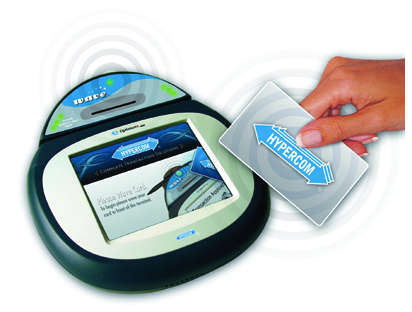
Merchants in the United States might be particularly reluctant to invest in the new technology. That’s because some invested in new terminals to read “smart cards”-credit cards with an embedded microprocessor that is read by placing it on an interrogator-only to see them sit idly because they weren’t embraced by consumers and because MasterCard and Visa couldn’t agree on a common smart card platform.
But the two card companies have come together on a single RFID platform. In March, MasterCard and Visa formally agreed to use a single RFID air interface protocol (the method of communication between transponder and interrogator). The two companies and American Express will all use ISO 14443, which was developed by the International Organization for Standardization and allows for the transmission of data to be encrypted for secure transactions. The common protocol means merchants can use one interrogator to read RFID cards from American Express, MasterCard or Visa. (Data is typically transferred in less than one-sixth of a second, compared with about a full second with a magnetic stripe card.)
The single payment infrastructure was an important hurdle to overcome, because consumers don’t want to have to carry around a different RFID card or keychain fob for each merchant they like to visit. Security concerns are another issue.
Credit card fraud often occurs when the consumer hands a waiter or retail employee their card and the person goes away to complete the transaction. An unscrupulous employee will write down the credit card number, expiration date and security code and then make transactions online or even make a counterfeit copy of the card. With RFID cards, the consumer never has to let go of the card.
Despite this, surveys show consumers are concerned about the security of their account information. Some fear that their RFID device could be read surreptitiously with a hidden interrogator. But the information stored on the RFID card is encrypted (to learn how card data is secured, see the box on opposite page).
Still, the issue of privacy remains. People are troubled by the idea that each and every transaction they make will be recorded and associated with their unique identification number stored in a database. The recent rash of security breaches at companies that store sensitive personal and financial information shows databases are consistently vulnerable to criminals. And there are times when people want to be anonymous. They rent movies, buy books and magazines and visit establishments that they’d rather others didn’t know about. There are ways to make RFID payments anonymous, but convincing the public of that will be a challenge.
Beyond Notes and Coins
RFID credit cards won’t take off until a critical mass of consumers start to carry them. “Chase says it will issue millions of RFID blink cards this year. But millions of cards won’t make a dent in the industry,” says O.B. Rawls, president of POS equipment manufacturer Hypercom North America. “If issuers are serious about it, they’ll have to issue scores of millions of cards.”
American Express recently announced that it’s embedding the ExpressPay RFID transponder in its Blue cards. The company won’t reveal how many of its 40.3 million card accounts belong to Blue cardholders or how many ExpressPay cards it’s issuing. MasterCard is assessing additional functionality that could be incorporated into PayPass cards, such as storing value on the card’s chip so that consumers could make either debit or credit transactions with the cards.
Visa’s Gauthier estimates that within the next 18 months, the major credit card companies will issue from 35 million to 50 million RFID cards. (Credit card companies prefer cards to fobs, phones and other devices, because they can have a magnetic stripe for conventional transactions.) More than half of these will be Visa cards. “One should take notice of the level of excitement, overall,” he says. “There are a number of issuers, all three payment brands, a large variety of merchants support contactless. This has been unheard of over the past 10 years with emerging payment technology.”
Not everyone is convinced RFID-based payments will take off. One skeptic is Marc Abbey, a partner with First Annapolis Consulting, a financial services consulting company. He believes that objective studies are needed to confirm the claims that RFID payment systems are faster. And Abbey says that RFID payments are not demand-driven: “They’re supply-driven, so a lot of activity is being driven by issuers and associations to generate primary demand.”
Ariana-Michele Moore, senior analyst with Celent Communications’ banking group, believes that RFID is a powerful technology that will impact payment systems significantly. But she’s not convinced that RFID cards will reduce lines and boost sales for all merchants. “You might speed up your transactions, but if you’re a quick-service restaurant, you can only make so many burgers,” she says. “At some point you’re going to have people waiting no matter how quickly they’re able to pay.”
It’s unclear when-or if-RFID payment systems will be adopted widely by businesses and consumers. While the credit card companies have agreed on a single RFID platform, another big issue needs to be resolved: creating a single secure payment infrastructure. Credit card providers already have a single network for processing payments, but it doesn’t support proprietary RFID payment systems, such as Speedpass. Ideally, merchants would be able to buy inexpensive interrogators, which plug into existing POS equipment, and connect to a single network to process all RFID payments. Agreeing on and creating this infrastructure will take time.
Some consumers who use and appreciate the convenience of toll, transit and gas payment systems will likely embrace RFID payment systems. Whether the vast majority of consumers will feel comfortable switching from cash to an RFID card for small purchases remains to be seen.
Sheetz Gets in the Fast Lane
“Speed is everything to us,” says Rich Steckroth, director of new business development for Sheetz, a chain of combination convenience stores and gas stations in the Midwest and Northeast. “Our parking lots are small and often nearly full, so the sooner we can get people in and out of the stores, the more people we can get into the lot.”
So about 18 months ago, Steckroth began investigating emerging payment technologies to see if they could speed things up. Pilot tests of RFID payment systems showed that consumers who used RFID cards (or keychain fobs or RFID-enabled cell phones) moved through lines faster than those paying with cash or magnetic-stripe payment cards. And they spent more money.
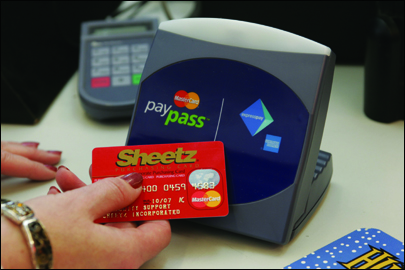
To Steckroth, the key value was faster transactions. When American Express, MasterCard and Visa announced that they would base their payment systems on a standard protocol so all three cards could be read by the same RFID interrogator, Sheetz decided to accept RFID payments from all three card companies.
“Getting our 314 Sheetz locations ready to accept RFID payments was like conducting an orchestra,” says Steckroth. All the companies that work together to process store transactions-from the switch provider (the party that sends payment information to a transaction processor, which seeks authorization from the card-issuing bank) to the settlement bank (which works with the credit card associations and the merchant’s bank to settle funds)-had to modify their systems to be able to handle RFID payments.
At the same time, Steckroth needed to equip the stores and gas pumps. Radiant, Sheetz’s point-of-sale terminal provider, and ViVOtech, an RFID terminal maker, worked together to install RFID payment terminals (Sheetz calls them Z-pass) in all of its convenience stores. Similarly, Panasonic, which supplies payment terminals for the gas pumps, worked with Gilbarco, makers of RFID payment terminals, to ready Sheetz gas pumps for RFID. Then everything had to be tested extensively.
Sheetz also decided it wanted its own RFID loyalty card. Steckroth worked with credit card issuer J.P. Morgan Chase to develop a cobranded RFID card. Cardholders get a 60-day introductory rebate of 10 percent on Sheetz purchases and accumulate points toward Sheetz gift cards.
Sheetz will not say how much it invested in the technology, but the average cost of RFID terminals is $125, and each of the chain’s 314 locations has, on average, three POS terminals.
Steckroth says it’s too early to see any return on investment. And he doesn’t think RFID payment systems are going to put a sizable dent in the cash payments market-at least not until, or if, banks start issuing RFID debit cards. Still, he predicts that between 5 percent and 10 percent of Sheetz transactions will be made with RFID cards within the next 12 months-and that those cardholders will be able to get in and out of Sheetz faster.
Will Identify Theft Kill RFID Payment Systems?
With almost weekly reports about credit card and bank accounts being hacked, exposing consumers’ private and financial information, consumers are wondering if RFID payment systems are safe. Could a thief read the tag in an RFID card with a mobile RFID interrogator and steal someone’s personal information?
Consumer fear just might be the biggest impediment to the adoption of RFID payment systems. “The messages about RFID are jumbled between the supply chain uses and the secure use of the technology in payments,” says Bruce Cundiff, a research analyst with Javelin Strategy & Research, which advises financial companies on e-commerce and identify fraud. “Consumers have this idea that someone could read their card surreptitiously and, as unlikely as that is, it’s still a scary proposition that might hinder the consumer carrying the card.”
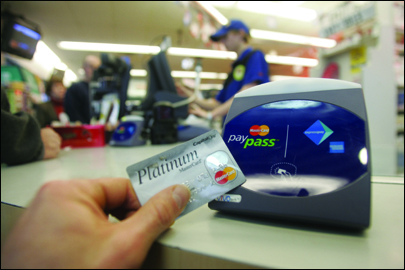
But Cundiff says that RFID payment devices offer a higher level of security than traditional payment cards. The American Express, MasterCard and Visa systems are based on the ISO 14443 standard, which allows the account information on the card to be encrypted; each company uses a different encryption method. In addition, unlike other protocols, this standard specifies a short read range of 4 inches (10 cm) between the card and the interrogator. That makes it difficult to surreptitiously read the data being transmitted between the card and the interrogator. But if a thief were to get a clear read of the tag, the encrypted information would be a useless string of data.
When the cardholder waves the card by an RFID payment terminal, it turns the encrypted number into a digital signature, which is passed through the payment network and then decrypted to authorize the transaction. To further protect the account information, the digital signature changes each time a card is read. So even if a thief were to somehow access the digital signature, it could not be used to make another transaction.
To facilitate one of the main benefits of RFID cards-faster transactions-merchants aren’t required by American Express, MasterCard or Visa to collect customer signatures for transactions under $25. But this doesn’t put consumers at risk for fraudulent charges. As with other credit cards, RFID cardholders can contest charges they didn’t make and not be held responsible for them. The card associations and issuers also exempt merchants from having to pay for charges that customers contest, if the charges are $25 or less.
Card associations and the banks that issue the RFID cards need to convey these messages clearly and consistently to consumers, says Cundiff. Merchants should reinforce the messages, too. But, says Cundiff: “The burden rests on associations and issuers to get the messages out.”

